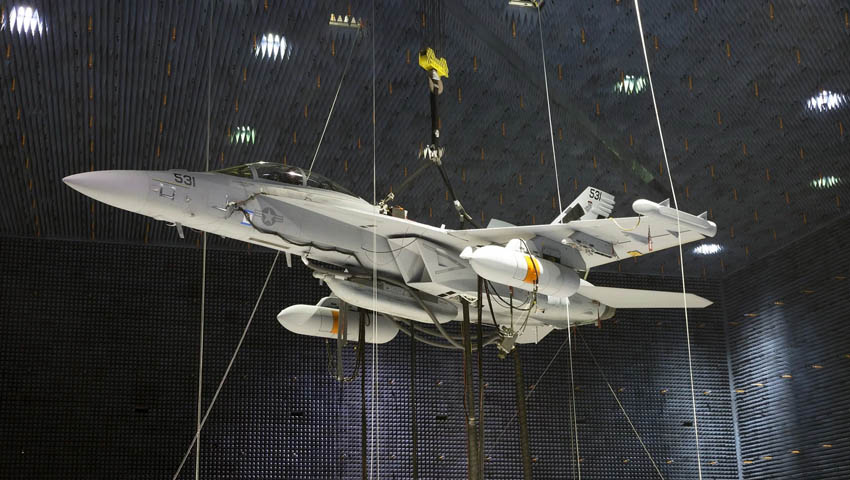The US Navy’s Naval Air Systems Command has hoisted a real EA-18G Growler electronic attack aircraft into the air at the Air Combat Environmental Test and Evaluation Facility anechoic chamber at Naval Air Station Patuxent River to test the Next Generation Jammer Mid-Band (NGJ-MB) pod.
To continue reading the rest of this article, please log in.
Create free account to get unlimited news articles and more!
As part of the testing process, the NGJ-MB Engineering Development Model (EDM) pods, developed by Raytheon, completed more than 400 hours of basic functionality, electromagnetic environmental effects (E3) data collection and performance testing over a period of three months.
US Navy Captain Michael Orr, Airborne Electronic Attack Systems (PMA-234) program manager, explained the importance of the test, stating, "This chamber test period was instrumental to the NGJ-MB Developmental Test program, and its success was the direct result of outstanding teamwork among the Program Office, Integrated Test Team, and Raytheon stakeholders."
Raytheon’s NGJ-MB architecture and design include the ability to operate at a significantly enhanced range, attack multiple targets simultaneously, and advanced jamming techniques. The technology can also be scaled to other missions and platforms.
The NGJ-MB system consists of two pods, referred to as a shipset, which will be loaded onto EA-18G Growler aircraft.
The system will provide significantly improved airborne electronic attack (AEA) capabilities against advanced threats in the mid-band frequency range through enhanced agility and precision within jamming assignments, increased interoperability and expanded broadband capacity for greater threat coverage against a wide variety of radio frequency emitters.
Unlike most capabilities that instantly replace its predecessor, the NGJ-MB systems will initially augment the legacy ALQ-99 Tactical Jamming System until the low- and high-band components are ready to deploy.
"Data captured during this period not only supports our initial flight clearance, but also provided lessons learned that will benefit the entire NGJ-MB test program moving forward," CAPT Orr explained.
Initially purchased alongside the more traditional Super Hornet variants to supplement Australia’s ageing fleet of classic Hornets and the diminished strike capability following the retirement of the F-111s, prior to the full integration of the Air Force’s 72 planned F-35s, IOC is expected to be delivered to the RAAF in the coming months.
Raytheon’s NGJ-MB ram air turbine generator is designed to give the Growler more power than it has ever had before to jam at unprecedented levels. Its open architecture and design allow the technology to be scaled to other missions and platforms.
Australia’s Growlers were part of a larger US Navy buy of 44 Super Hornets and Growlers in July 2014, with the first Australian EA-18G making its first flight in July 2015. All 12 of Australia’s Growlers were formally welcomed to their home base at RAAF Amberley in 2017, providing air crews and pilots the opportunity to build familiarity and an understanding of the aircraft and its unique capabilities.
Based on F-18E/F Super Hornet variant of the wildly successful Boeing Hornet, the EA-18G Growler has proven itself to be an invaluable asset to the US when deployed overseas. As the only nation besides the US to fly the Growler, Australia has developed unique training procedures in conjunction with US Navy partners to fully utilise the capabilities of the aircraft.
It is now expected that the Growlers of No. 6 Squadron RAAF will be capable of providing limited, force-level electronic warfare. This means that until final operating capability (FOC) is achieved, the aircraft will be largely limited to peacetime operations or responding to regional contingencies as needed.
The Growler incorporates a number of advancements over the traditional Super Hornet, including:
- An additional avionics suite;
- Enhanced radio frequency receivers;
- An improved communications suite; and
- ALQ radio-frequency jamming pods, which enable it to jam enemy systems.
FOC for Australia’s Growlers is expected in 2022. Reaching FOC will require additional testing and broader integration with key ADF assets, particularly the Navy’s new air warfare destroyers, Air Force’s E-7 Wedgetail AEWC aircraft and later F-35s and key ground assets of the Army to ensure that the ADF is developed into a full-spectrum, integrated force.
Raytheon, with 2018 sales of US$27 billion and 67,000 employees, is a technology and innovation leader specialising in defence, civil government and cyber security solutions.
With a history of innovation spanning 97 years, Raytheon provides electronics, mission systems integration, C5I products and services, sensing, effects and mission support for customers in more than 80 countries. Raytheon is headquartered in Waltham, Massachusetts.
Stephen Kuper
Steve has an extensive career across government, defence industry and advocacy, having previously worked for cabinet ministers at both Federal and State levels.

 Login
Login








